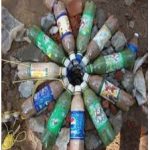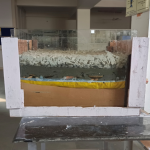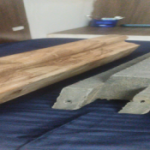- Home
- About
- Academics
- Admissions
- Research & Outreach
- Training & Placement
- Student Life
- IQAC

The Peralite thermally insulated brick can be used at places with high temperature (more than 45° C). Ordinary bricks do not insulate the sufficient amount of heat as the chief ingredient is clay. The temperature variance from outside the building is very less. Thus the project focused to develop the brick with the help of Peralite (waste product). The different tests had to be carried out relative to the water absorption, compressive strength and most importantly its adaptability in the humid conditions of Rajasthan.

PET bottles constitute about 50% of the total waste disposable in the world. In the effective utilization of the waste PET bottles an initiative was taken by the students regarding their project. The PET bottles were filled and compacted with the help of demolished wastes and compacted. The initial tests regarding Compressive strength, tensile Strength and the durability parameters are analyzed. In continuation of this, it had been planned to construct a structural sample using the PET bottles.

A very new and innovative approach of analysis and design of flexible pavement were carried out by using the latest software IIT Pave which was developed by researchers at the Illinois Institute of Technology (IIT). It is a software package that facilitates rapid, accurate and reliable flexible pavement design. IIT Pave software is used for analyzing the strain (tensile and vertical) in pavements and later the obtained results are compared with the actual. This research aims to broaden the scope of pavement design by incorporating alternative materials such as cementitious and reclaimed asphalt, and analyzing them with the IITPAVE software.

It involves the analytical observation of a system to monitor changes to the material and geometric properties of engineering structures such as bridges and buildings. The SHM process involves selecting the excitation methods, the sensor types, number and locations, and the data acquisition/storage/transmittal hardware commonly called health and usage monitoring systems The project comprised of a prototype model of a bridge of span length 15 m and vibratory sensors were installed at every 2 m distance to monitor the stability. The different frequencies of vibration resembled the load moving over the prototype. The sensors were installed in accordance with STAAD Pro software which showed different stability formation on changing the loading parameters. The analysis was compiled.

It involves the analytical observation of a system to monitor changes to the material and geometric properties of engineering structures such as bridges and buildings. The SHM process involves selecting the excitation methods, the sensor types, number and locations, and the data acquisition/storage/transmittal hardware commonly called health and usage monitoring systems The project comprised of a prototype model of a bridge of span length 15 m and vibratory sensors were installed at every 2 m distance to monitor the stability. The different frequencies of vibration resembled the load moving over the prototype. The sensors were installed in accordance with STAAD Pro software which showed different stability formation on changing the loading parameters. The analysis was compiled.

The project aims to convert the organic waste (from kitchen like vegetables, fruit peels and wasted food) into biogas which can be used for cooking. It is portable therefore can be set up in a very small space. By product from this digester can be used as fertilizer for gardening. It is 100% eco-friendly and economical. The design parameters are checked and the gas was collected. No expert supervision is needed therefore can be effectively used anywhere (city or rural areas) by a small family.

The concept behind the “Bloqueplas 2.O” is the construction of affordable houses using plastic waste. The project was carried by our students in collaboration with an American- based construction company “TICO ARQUITECTURA” at COSTA RICA. The blocks are lightweight, modular and can easily be coupled; also they do not require skilled labor. This system seeks to offer an alternative future for the manufacture of structural and non-structural elements for the construction of architectural projects, by generating a construction system integrated with light elements, Modular resistant, allowing quick installations, safe and inexpensive.